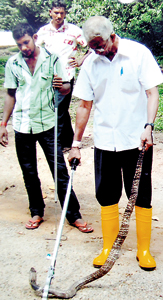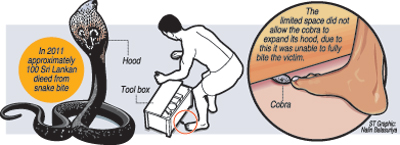News
Cobra snaps ST photographer
It was last Sunday morning when Ranjith Perera’s wife complained of a termite infestation in a cupboard. He decided to apply some wood preservative on it and went to fetch a paintbrush.

Mr. Perera shows how to catch a a cobra
“I was looking for a paintbrush, when I felt a sudden sting on my toe,” said Ranjith, recalling his unexpected brush with death. “I thought, maybe it was a nail and moved the toolbox. Then I saw a snake under the box.”
The cobra was hidden in an inch of narrow space between the bottom of the box and the floor.
His wife and older son immediately rushed him to the Homagama Hospital. He was wheeled into the premises, but a careless nurse made him walk to the ward, much to the attending physician’s chagrin.
The doctors promptly tested his blood and gave him a tetanus shot. They asked Rajith if he had double vision, headaches, etc, but Ranjith only felt pain in his leg.
“They took samples of my blood every two hours, to ensure everything was normal,” Ranjith said, “My pressure went up. I was told to drink lots of water. I was in the hospital for three days.”
Sometime after he was admitted to hospital, Ranjith’s younger son called neighbour Lesley Perera, a serpent catcher and People’s Bank retiree, to catch the cobra.
“I was able to catch the cobra with a special serpent catching tool,” Mr. Perera said. “I made the device myself and I have the patent rights to it too. This is the 157th snake I have caught since 2006.”
The cobra was taken to the hospital, so that, Ranjith’s doctors could identify the species. Since then, the serpent has been in the custody of the Dehiwala Zoo.
Fortunately for Ranjith, only a small amount of venom had entered his body. Mr. Perera said a snakebite is fatal only when the venom glands of the snake are stimulated, for example, when it’s preying, feeding or caused pain. When Ranjith was bitten, the cobra’s venom glands were not stimulated, as the snake was instantly reacting to a sudden change in environment.
“Snakes release more venom if they are disturbed or threatened,” Wijaya Ananda, a biodiversity conservation officer with Rainforest Rescue International, said.

“A prime example is when people get grievously bitten while trying to catch snakes, because the animal releases more venom under threat,” he added. “A similar dangerous situation occurs when people step on snakes; the animal is hurt and delivers a venomous sting. It’s worse when the victim doesn’t realise there’s a snake under his/her feet, when the animal may prolong its bite.”
Mr. Perera said that cobras are one of the highly venomous serpent species often seen in suburban areas of Colombo. Mr. Ananda said the most often seen serpents in this region are the hump-nosed viper (“kunakatuwa”), Russell’s viper (“thith polaga”) and the cobra (“nayaa”). He added that venomous snakes such as the saw-scaled viper (“veli polanga”), common krait (“karavala”) and the Sri Lankan/Ceylon krait (“mudu karavala”) are found mostly in the Dry Zone region, as their numbers have dwindled in suburban areas.
“Now there aren’t as many serpents because of habitat destruction,” Mr. Ananda said. “When the animals lose their original habitats, they are displaced to residential areas, where they hide in plant-pots, woodpiles and rock-piles. People end up with snakebites when they go to clean these places.”
Mr. Perera said it’s crucial not to panic and agitate the serpent while in its presence.
“I worked with the Young Zoologist’s Association for nine years, where I studied and conducted various lectures on serpents,” he added. “The most important thing is not to panic when you see a snake or a serpent. You should be calm and let it move away, and no harm will be caused.”
“Treatment should be immediate for a snakebite,” Mr. Ananda said, as delay in treating the bite, increases the risk of the venom affecting the nervous system and passing through the kidneys or the heart, causing further complications. Mr. Ananda suggested the following First Aid for snakebite victims:
- Gently cleanse the wound with clean water
- Keep the patient relaxed and calm. If the patient is agitated or fearful, the situation could become worse. Movement and muscle contractions can speed up release of venom into the bloodstream and lymphatics.
- Rush the patient to the nearest hospital or medical facility.
- If possible, capture the snake that bit the patient, so the attending doctors could identify its species.
- Do not tie up the wound with bandages, ligatures or any other tight tourniquet. Doctors now advice against it.
- Do not treat the wound with any ointments, herbs or chemicals. It’s best to avoid any interference with the wound to reduce risk of the venom spreading.
- Do not give the patient any medicine including Panadol or Paracetamol.
- Under any circumstances, DO NOT attempt “traditional” methods of snakebite treatment such as sucking on the wound or making incisions to try to bleed the wound.
Follow @timesonlinelk
comments powered by Disqus






















